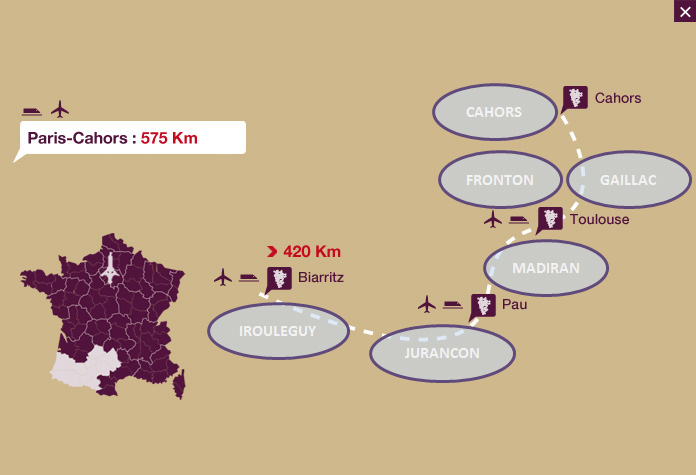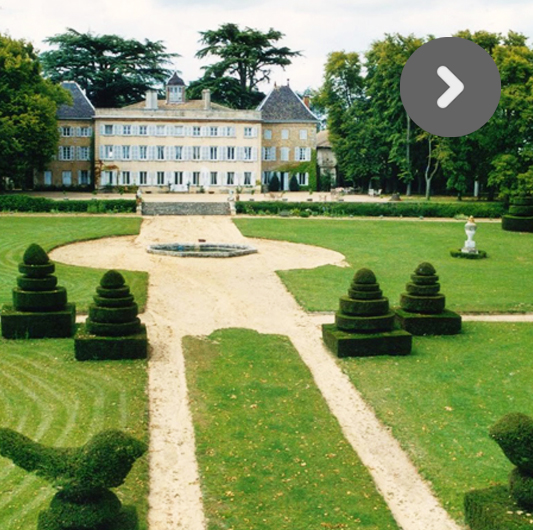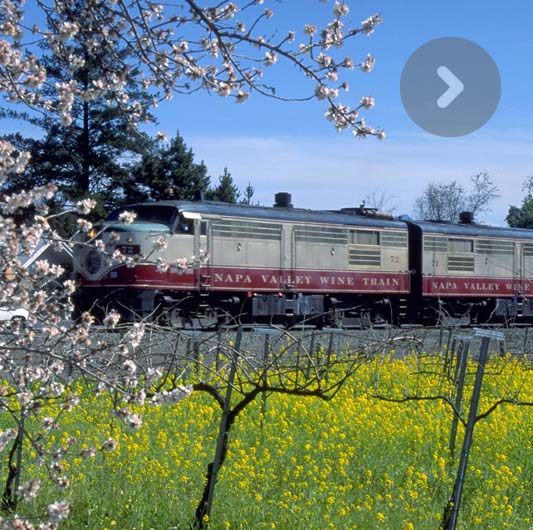







HISTORY AND LAND
The vines of the South West region are thought to be the oldest. Their implantation with plants from the Cotoïde, côt and tannât families date back from Roman times. The biturica, cited by Pline, is thought to be none other than the ancestor of the cabernet vine plant. The Gauls grew vines near Gaillac. The cabernet franc, fer servadou and merlot vine plants were introduced by pilgrims during the Middle-Ages, who would spread news and vine plants during their pilgrimages.
Thereafter, vines developed along the country paths and roads that led to Compostella. The monks in the abbeys and sections, always hospitable, cultivated the vines in order to produce holy wine and something comforting to offer pilgrims. The great emperor Charlemagne, Henri IV, the béarnaise, Louis XIV, all kings of France each made their own mark on the history, reputation and trade of wines in the South West.
Between hills and mountains.
The wines of the South West stretch over 500 kilometres, over 12 counties with Toulouse as a capital. The towns of Cahors, Pau and Biarritz also hold an important position. An enormous garden of vines that harbour the route from the Aveyron to the Basque region. The vineyards follow the line of the Pyrenees to the south and the Central Massif to the north. The Bergerac and Monbazillac run along the canal that borders the Garonne river all the way to Agen and honour foie gras and Armagnac. Albi promotes Gaillac wine. The Cahors Malbec follows the meandering Lot river. The Béarn wines line the Pyrenees. The wines of the Irouléguy take root on the steep and sun-drenched slopes of the Basque country and run to the Atlantic and the Spanish border. A marvellous wine tourism tour!
Tradition and modernity.
Fronton, Gaillac, Côtes de Duras, Bergerac, Pacherenc…However diverse, each of these AOC have in common the fact that their vines are planted on higher ground, in order to keep them from the cold and produce wines of character to share.
Historical châteaux and feudal castles that date back to the Middle-Ages and whose owners have since returned to working on vines have survived in the highly diversified landscape of this winegrowing world. For the most part, the estates, farms and bourgeois properties each cultivate about ten hectares of vineyards. Where traditional polyculture used to be favoured, the focus is now on the cultivation of vines. Along the years, the winegrowers started bottling the wine and became producers. From generation to generation they have developed wines, in the greatest tradition, with black and white merlot, sauvignon and cabernet sauvignon grapes. The modern touch is to blend them with “forgotten” grapes. Old grape varieties, rare and reintroduced, the names of which celebrate their land of origin, such as the chenin, the carmenet, the acteria and the côt for the reds; the petit and gros manseng, the courbu and the l’en de lel for the whites. Connoisseur wines with deep accents.
WHO’s WHO, INSPIRING LAND
The South-West Chart.
Leading it, Henri IV, the béarnais, King of France and of Navarre who was born in Pau. Baptised with a clove of garlic soaked in wine that was rubbed on his lips, to give him strength and stamina, the future King of France will promote Jurançon wines. An excellent communicator, the King would laud the virtues of “ploughing and grazing” as well as those of good wines. Another future sovereign born in Pau, Jean-Baptiste Jules Bernadotte who became King of Sweden under the name of Charles XIV. His descendants still reign over the Kingdom of Sweden. In his cloak and dagger novel The Three Musketeers, Alexandre Dumas upheld the values of Gascony. His characters really did exist. Porthos, Athos and Aramis were from the Béarn region. D’Artagnan was from Tarbes.
In 1848, the city of Pau hosted, under surveillance, the Emir Abd el Kader. The writer Frédéric Beigbeder spent his childhood at the Villa Navarre, since transformed into a boutique hotel. The designer André Courrèges is a son of the town, the sociologist Pierre Bourdieu studied at the Pau college and the politician François Bayron lives there.
Pau « so british ! ».
The English discovered Pau in the XIXth century and adopted it. In 1814, Lord Wellington settled there with his officers. He was delighted by his stay in Pau and encourages the whole gentry to come to this delightful leisure destination. The poet Lamartine sings its praise and the young British doctor Alexandre Taylor values it for its healing virtues. A rejuvenation for Alfred de Vigny who met and later married Lady Burnburry while Frantz Lizt chased after a few beautiful countesses. Pau is so chic!
A Haven in the lot
Born in Cajarc, the novelist Françoise Sagan, Quoirez of its real name, used to enjoy sharing her love for the landscapes of the Lot region with her friends. A square is named after her just a few steps away from the house she was born in. President Georges Pompidou and his wife Claude owned their “Bergerie” at Prajoux, near Cajarc, where they would come and find refuge as often as they could. Further south, on the Limogne plateau, the film maker Louis Malle had retired to a house in the village of Lugagnac. He lived there with his successive wives, the actresses Alexandra Stewart and Candice Bergen. His film “Lacombe Lucien” was filmed in Figeac and a part of “Milou in May” was filmed in front of the landscapes of the Causse.
Saint-Cirq-Lapopie resists time but not fashions. The Surrealist André Breton resided in the village from 1951 to 1966. He would say that “he had stopped desiring anywhere else” and would invite Man Ray, Max Ernst, Dali and many others to enjoy his refuge in the Lot. The sculptor Zadkine owned a property at the heart of the village of Les Arques. Next to the chapel, a small museum, full of his pieces, was erected in his memory. It is in his « dungeon » of the Lot that overlooks the valley of Latour, near Belaye, that Mime Marceau would like to come and rest after long international tours.
White russians in the roaring Basque country
For history, the courageous Roland, Charlemagne’s comrade in arms, lost his life at Ronceveaux. “Roland’s path”, a path carved out of the rock above Itxassou. It in the centre of the Bidassoa, a small river that runs into the sea at Hendaye, that François Ist prisoner of Spain was released and exchanged for his sones. Although Napoléon Ist and Victor Hugo had already enjoyed the beauty of the Basque coast, it is the Empress Eugenie, wife of Napoléon III, who made Biarritz’ reputation. She was followed by Edward VII of England and the whole court of Imperial Russia, the Grand Duke, the Tsar Alexander III and the white Russians in exile. Stravinsky composed “The wedding” for Diaghilev, a piece inspired by Russian popular culture. His sweetheart, the famous Coco Chanel, would often come and join him there. It is in Biarritz that the writer Nabokov met his Lolita. It is there that Picasso, seduced by the town, spent his wedding night with Olga Khoklova and painted the painting “Les Baigneuses” in 1919.
The novelist Pierre Loti, author of Ramuntxo, lived and died in Hendaye in his house he named Bakeretxca. The novelist Edmond Rostand, author of the famous Cyrano de Bergerac, lived in his fabulous neo-basque house, Arnaga at Cambo les Bains, now a museum. The composer Maurice Ravel was born in Ciboure in 1875. The beautiful city, opposite Saint-Jean de Luz, dedicated a Music Academy. In another register, the operetta singer, Luis Mariano, of basque Spanish origin was buried in the village of Arcangues. It is still flowering forty years later. Jean Borotra, known as the «roaring basque», is one of the four musketeers of French tennis. From 1922 to 1947, he won 36 of 54 matches played in the Davis Cup, an exploit! The Basque country also saw two talented footballers born there: Didier Deschamps and Bixente Lizarazu who is from Saint-Jean de Luz.










